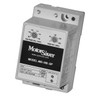Product Description
Description: 1-Phase Voltage Monitor/95-120V/adj.RD/DIN rail
| Product Information | Resources |
|
| Specifications |
| Product Attribute | Attribute Value |
| Input Voltage (V) | 95 - 120 Vac |
| Maximum Input Power | 6 |
| Input AC Line Frequency (Hz) | 50 / 60 (50 will increase all delay timers by 20%) |
| Output Form | 1 Form C |
| Output Load Rating (VA) | Pilot Duty: 480 VA @ 240 Vac B300; General Purpose: 10 A @ 240 Vac |
| Restart Delay Range | 1 - 500 s adjustable |
| Trip Delay Range | Under/Over Voltage: 4 s |
| Trip Point Accuracy (%) | ±1% |
| Overvoltage Trip Voltage (%) | 1.1 |
| Overvoltage Reset Voltage (%) | 1.07 |
| Undervoltage Trip Voltage | 0.9 |
| Undervoltage Reset Voltage (%) | 0.93 |
| Protection Class | IP20; NEMA 1 (finger safe) |
| Termination Type | Torque: 6 in-lbs; Wire: Stranded or solid 12 - 20 AWG one per terminal |
| Mounting Method | 35mm DIN rail or Surface Mount (#6 or #8 screws) |
| Operating Temperature | -40° to 70°C (-40° to 158°F) |
| Storage Temperature (F/C) | -40° to 80°C (-40° to 176°F) |
| Humidity | 10 - 95% non-condensing per IEC 68-2-3 |
| Dimensions | 3.5 H x 2.08 W x 2.35 D in. (88.9 x 52.9 x 59.7 mm) |
| Series Features |
| 460-XXX-SP SERIES - Single-phase voltage monitor |
| Series Description: The 460-100-SP is used on 95120 V ac, 50*/60 Hz single-phase motors and the 460-200-SP is used on 190240 V ac, 50*/60 Hz single-phase motors to protect them from damaging high and low voltage conditions. An adjustment knob allows the user to set a 1500 second restart delay. The variable restart delay is also a power-up delay and can be utilized to stagger-start motors on the same system. A unique microcontroller-based, voltage-sensing circuit constantly monitors the voltage to detect harmful power line conditions. When a harmful condition is detected, the MotorSavers output relay is deactivated after a specified trip delay. The output relay reactivates after power line conditions return to an acceptable level and a specified amount of time has elapsed (restart delay). The trip delay prevents nuisance tripping due to rapidly fluctuating power line conditions. |
|


